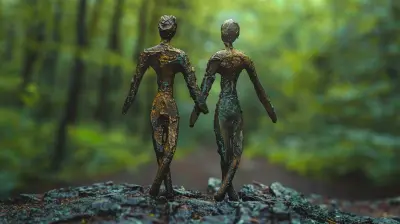Attachment Theory and Trauma: How Early Experiences Shape Us
31 October 2025
Ever wonder why you react to relationships the way you do? Why some people crave closeness while others push it away? The answers may lie deep in your past—woven into the fabric of your earliest experiences. Attachment theory suggests that the way we bonded with our caregivers as children profoundly shapes the way we connect with others throughout life. But what happens when trauma disrupts this delicate process? Let's dive into the mysterious world of attachment and uncover how early experiences carve the blueprint for our emotional world.

What Is Attachment Theory?
Attachment theory, originally developed by psychologist John Bowlby, explains how our early emotional bonds with caregivers shape our ability to form relationships later in life. From infancy, we're wired for connection—it’s part of our survival. Based on how our caregivers responded to our needs, we develop a specific attachment style that sticks with us into adulthood.The theory outlines four main attachment styles:
1. Secure Attachment – Healthy and balanced relationships, formed when caregivers are consistently responsive.
2. Anxious Attachment – Fear of abandonment and a strong need for reassurance, often stemming from inconsistent caregiving.
3. Avoidant Attachment – Emotional distance and self-reliance, typically developed when caregivers are emotionally unavailable.
4. Disorganized Attachment – A mix of anxious and avoidant tendencies, often linked to traumatic or abusive early experiences.
But here’s the catch—our attachment style isn’t just about relationships. It infiltrates our self-worth, emotional regulation, and overall mental health. And when trauma enters the picture? Things get even more complex.

The Dark Shadow of Early Trauma
Trauma, especially in childhood, significantly impacts attachment development. If a child experiences neglect, abuse, or emotional unavailability, their ability to trust and connect with others can become deeply fractured. This is because the brain, at a young age, is incredibly malleable. Negative experiences become hardwired in ways that can make relationships feel dangerous rather than safe.How Trauma Affects Attachment Styles
Let’s break it down:- Trauma and Anxious Attachment
If a caregiver is unpredictable—sometimes loving, sometimes distant—a child learns that love is unreliable. This creates clingy, anxious behaviors in relationships, as they constantly seek reassurance to avoid abandonment.
- Trauma and Avoidant Attachment
If a child’s emotions were consistently dismissed or punished, they may develop a deep fear of vulnerability. As adults, they avoid intimacy, preferring emotional distance to protect themselves from rejection.
- Trauma and Disorganized Attachment
When a caregiver is both a source of comfort and fear (such as in cases of abuse), the child experiences deep internal conflict. They crave attachment but also fear it—leading to chaotic relationships and difficulty trusting others.
This isn’t just psychology jargon—it’s the invisible script running in the background of our lives, dictating how we love, trust, and connect.

The Long-Term Impact of Early Attachment Wounds
Attachment wounds don’t just disappear as we grow up. They manifest in our relationships, self-esteem, and even mental health conditions. If early bonds were broken, they can lead to:- Relationship struggles – Difficulty trusting, fear of abandonment, emotional unavailability.
- Low self-worth – Feeling unlovable, never good enough, or constantly seeking validation.
- Emotional dysregulation – Overreacting to minor issues or shutting down emotionally.
- Mental health issues – Higher risk of anxiety, depression, and even personality disorders.
The mind remembers what the heart has endured. Even if we don’t consciously recall childhood pain, our nervous system carries the scars.

Can We Break Free from Attachment Trauma?
Here’s the good news—attachment wounds can heal. While our early experiences shape us, they don’t have to define us forever. Healing is absolutely possible, and the brain has something incredible called neuroplasticity, which allows it to rewire and form healthier patterns over time.Steps Toward Healing
1. Recognize Your Attachment StyleSelf-awareness is the first step. Identifying your attachment tendencies allows you to understand your triggers and patterns in relationships.
2. Therapy and Inner Work
Seeking therapy, especially attachment-based therapy or EMDR for trauma, can help rewire old wounds and build healthier relational patterns.
3. Practice Secure Attachment Behaviors
Even if you didn’t grow up with secure attachment, you can learn it. This means practicing healthy communication, setting boundaries, and allowing emotional vulnerability in a safe environment.
4. Surround Yourself with Safe People
Healing happens in relationships. Finding supportive, empathetic individuals can help you redefine trust and connection.
5. Reparent Yourself
Sometimes, healing means becoming the caregiver you never had. Learning self-compassion and emotional regulation can help you give yourself the security you lacked as a child.
The Hope Beyond the Hurt
Yes, early experiences shape us—but they don’t have to imprison us. The power to heal resides within us, no matter how deep the wounds run. While attachment trauma may whisper lies of unworthiness and fear, the truth is this: You are capable of love, connection, and healing.Your past wrote the beginning of your story, but you hold the pen now. How will you write the next chapter?
all images in this post were generated using AI tools
Category:
Attachment TheoryAuthor:

Paulina Sanders
Discussion
rate this article
1 comments
Bellamy Garcia
This article beautifully highlights the profound impact of early experiences on our emotional well-being. Thank you!
November 16, 2025 at 5:05 AM

Paulina Sanders
Thank you for your kind words! I'm glad you found the article meaningful.


